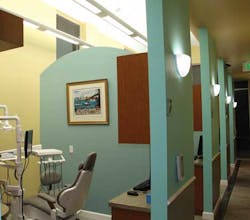"You can't afford NOT to go digital"
By William Choi, DMD, FICOI
During my first job right out of dental school, I found myself in a small darkroom with that familiar, dense chemical odor and the annoying hum of the developer. While waiting anxiously to see if my film had captured what I needed, I told myself that once I had my own practice, I would never touch film again.
Now that I have my practice in San Leandro, Calif., I have intraoral digital sensors in each operatory, with the computers stored in a neat and tidy place out of view. The countless hours I spent developing and handling film made choosing digital imaging technology very easy. One major concern I hear often about upgrading to digital radiography is cost, but I can tell you that not upgrading will prevent you from maximizing your income. I can tell you firsthand that the benefits of a digital upgrade more than make up for the cost. I can tell you about the many different ways digital radiography reduces my costs, but for now I'll focus on a few of the advantages of digital versus film.
1. Labor — Intrinsic to film radiography is the labor required to process and develop film X-rays. The biggest contributions to overhead in my office are the staff and associate dentists. In an office with more dentists than assistants, time spent developing X-rays is time lost from diagnosing and treating the more than 150 new patients that come to our office every month. Compared to the digital sensor that can capture and display an image to both the patient and doctor in two seconds, a film X-ray can take 20 to 30 minutes to develop, which adversely affects the number of patients a dentist can see in a day.
2. Costs — Without factoring in labor, the ADA estimates that every film X-ray costs about $1.11. A practice that averages 500 X-rays per month will spend nearly $6,000 a year on film X-rays alone, and that doesn't even include the time wasted in the darkroom developing the film. With digital intraoral sensors starting at around that same price, a practice that switches from film to digital will regain the initial capital costs in just one year.
3. Convenience — The inherent costs of film X-rays extend to the storage and duplication of the original radiographs. Digital X-rays afford the ease and convenience of creating perfect radiographic duplicates that can be sent electronically to specialists and insurance companies, and can accompany referrals. In addition, the ability to manipulate and refine images from a computer to create more contrast or enlarge a particular area eliminates the costs associated with retaking X-rays due to over- or underexposure. My digital intraoral sensors are integrated with the existing practice management software system, making it even easier for me to store and access patients' digital X-rays.
4. Patient consultation — I know that I would not be able to see as many patients with film, largely due to the extra time it takes to consult with patients about treatment plans when showing them film X-rays. Digital imaging, which directly displays an image to the patient on a monitor where a dentist can interact with the X-ray and enhance parts of the image, significantly reduces patient consultation time as well as increases treatment plan acceptance.
5. Safety — With recent studies finding that frequent dental X-rays are linked to an increased risk of brain tumors such as meningioma, the difference in amount of radiation exposure between film and digital X-ray is paramount to a patient's overall health and safety, as well as to the health of the dentists and assistants working in the practice. Film X-rays expose patients to as much as 80% more radiation than digital sensors, but the health concerns are not just limited to radiation exposure. The chemicals used to process and develop film X-rays in darkrooms generate dangerous wastes, to which the dentists and assistants handling the chemicals are exposed.
I have a true commitment to a higher quality of care, and digital radiography is one of the many things that prove this to both my patients and staff.
William Choi, DMD, FICOI, is in full-time practice in San Leandro, Calif., is an Assistant Clinical Professor at UCSF Hospital Dentistry, and is a Fellow of the International Congress of Oral Implantology (FICOI). He has a strong interest in using the latest dental technology, including 3-D imaging (CBCT) for surgical planning and diagnosis. You may reach Dr. Choi at [email protected].

